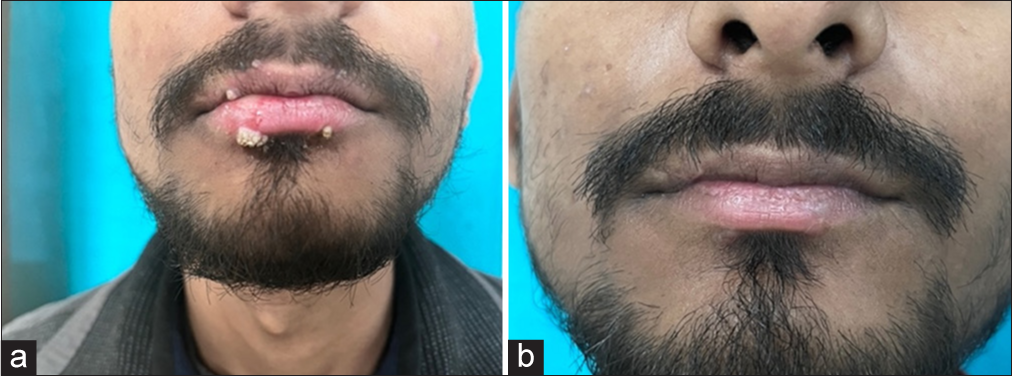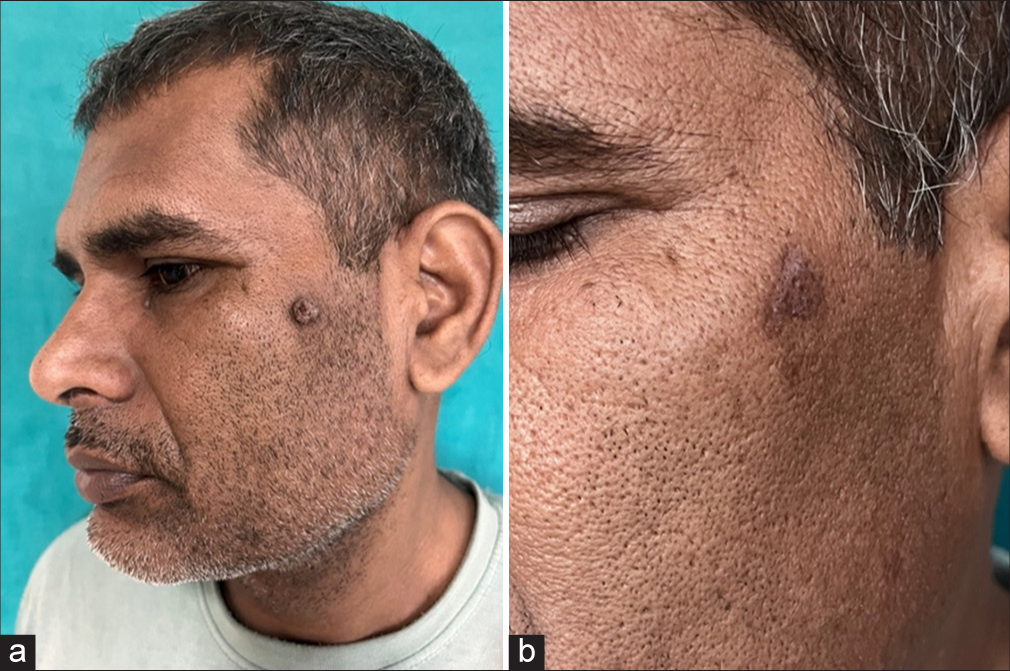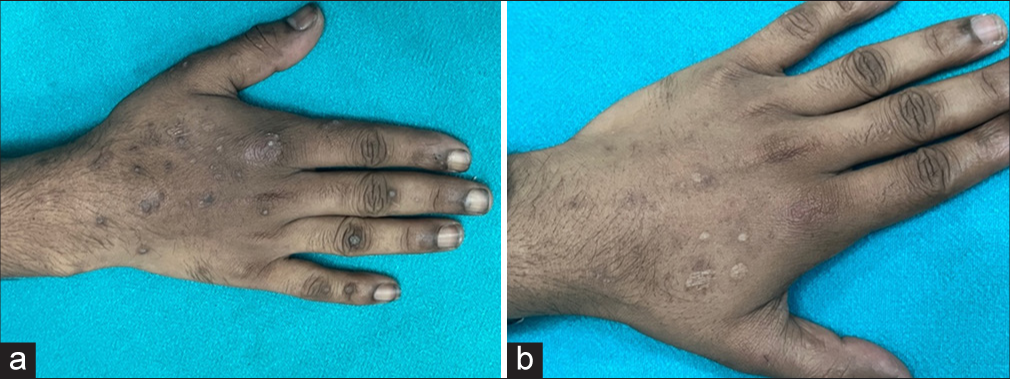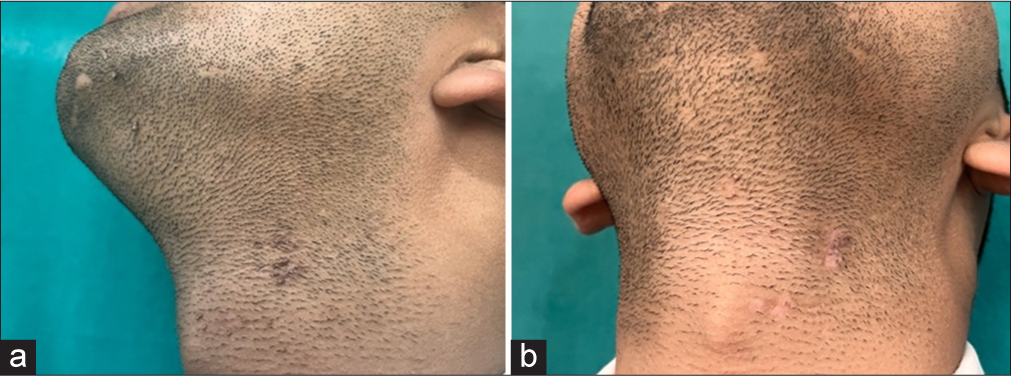Translate this page into:
Long-pulsed neodymium-doped yttrium aluminum garnet laser as a therapeutic modality in untreated and recalcitrant warts
*Corresponding author: Deepika Uikey, Department of Dermatology, Employee’s State Insurance Corporation Medical College and Hospital, Faridabad, Haryana, India. deepika.nikh@gmail.com
-
Received: ,
Accepted: ,
How to cite this article: Dani I, Uikey D, Ramesh V, Passi S. Long-pulsed neodymium-doped yttrium aluminum garnet laser as a therapeutic modality in untreated and recalcitrant warts. J Cutan Aesthet Surg. doi: 10.25259/JCAS_76_2024
Abstract
Objective
The objective of this study was to study the treatment efficacy of long-pulsed Nd:YAG laser in untreated and recalcitrant cases of verruca vulgaris.
Method and Materials
Nd:YAG long-pulsed laser (1064 nm) was used as a treatment modality in 40 patients of verruca vulgaris. Four sessions of laser treatment were done 2 weeks apart. Patients were given treatment for 2 months and monthly follow-up for the next 3 months after treatment to note relapse.
Results
Out of 40 patients in the study, varied clinical presentations were included – perioral warts, facial, plantar, palmar, periungual, and multiple warts on hands and feet. Response to treatment was recorded as the number of sessions required to clear the lesion, which varied depending on the site of the lesion and type of clinical presentation. Warts on the face and neck were cleared in a single session, whereas palmoplantar lesions required 3–4 sessions. Out of the 40 patients, 29 showed complete clearance without any relapse after 3 months of follow-up, whereas nine patients showed partial clearance, and two were lost to follow-up.
Conclusions
Long-pulsed Nd:YAG laser is an effective modality in clearing verruca vulgaris and preventing relapse as compared to conventional treatments.
Keywords
Warts
Nd:YAG laser
Recalcitrant warts
INTRODUCTION
Verrucae vulgares, commonly known as warts, manifest on the skin and mucosa as a consequence of human papillomavirus (HPV) infection, leading to the development of benign epithelial proliferations.1 Worldwide, the prevalence of warts ranges from 7% to 12%.2,3
Transmission occurs through either direct contact with skin-to-skin or indirect contamination of inanimate objects when there is a breach in the integrity of the skin barrier. Cosmetic problems and physical discomfort such as pain and interference of function caused by it, significantly impact a patient’s quality of life. These complications, along with the risk of translocation to other areas of the skin, are indications for treatment, which can be challenging. There is no antiviral treatment specific to HPV. The common approach is to damage the infected epithelium, while others are immunomodulatory, antiproliferative, or virucidal.2 Approximately 30% of warts regress spontaneously within the first few months of appearance, more so in children.1 The treatment focuses on preventing further spread, decreasing infectivity, and addressing cosmetic concerns. Topical therapy, cryotherapy, surgical excision, and electrocautery are traditional therapeutic options for warts. However, these approaches offer incomplete clearance, leading to the recurrence of lesions within 4 weeks.4
Ablative lasers, like CO2 laser with a 70% success rate, are among the newer modalities, while non-ablative lasers, such as neodymium-doped yttrium aluminum garnet (Nd:YAG), boast a higher success rate (96%).5,6 Nd:YAG laser effectively eliminates the virus in the basal layer of the epidermis due to its capacity to achieve deeper penetration at 1064-nm wavelength, making it a preferred choice over alternative laser treatment options. Hence, we conducted this study to assess the efficacy of long-pulsed Nd:YAG laser in managing warts and documented the post-treatment recurrence.
MATERIAL AND METHODS
Study design and settings
This was a hospital-based observational type of prospective study of 6 months duration conducted at the Department of Dermatology, Venereology and Leprosy, ESIC Medical College and Hospital, Faridabad. The study commenced after obtaining approval from the Institutional Ethical Committee.
Study population
The accessible population was the patients visiting the outpatient clinic.
Inclusion criteria
All newly diagnosed cases of warts of age >18 years
Patients are not responding to other conventional treatment modalities, including topical treatment, radiofrequency ablation, and cryotherapy.
Exclusion criteria
Genital warts
Verruca plana
Pregnant or lactating women
Patients suffering from other skin disorders
Patients on steroids or immunosuppressants for any other disease
Patients with immunocompromised state.
Sample size
The total duration of the study was 6 months. In the 1st month, we enrolled all patients who met the inclusion criteria. After enrolment, they received treatment for 2 months, followed by monthly follow-up for 3 months after treatment to observe any relapse. Based on the outpatient load in the department, we enrolled 40 patients in the study during the 1st month.
Study intervention
The study included all the patients who met the inclusion criteria. As per the pro forma, we recorded the essential demographic parameters (age, sex, and occupation), clinical history, and treatment history of the recruited patients. After obtaining consent from the patient, Nd:YAG long-pulsed laser (1064 nm) was used as a treatment modality with the following parameters:
Spot size: 4–5 mm
Fluence: 140–150 J/cm2
Pulsed duration: 40–50 ms
Number of passes: 5–10 with slight overlap including 1 mm perilesional normal skin
Number of sessions: Four sessions of laser treatment 2 weeks apart.
Patients who could not tolerate the pain during the procedure received local anesthesia as injectable lignocaine before the procedure. Before and after the procedure, clinical photographs of all the patients were taken. After the procedure, we advised topical antibiotic cream to be used for 1 week.
Using the following terms, we evaluated the clinical response of patients in our study:
Complete clearance – complete resolution of a clinically apparent wart
Partial clearance – persistence of lesion even after four sessions of laser treatment with some reduction in the size from the pre-treatment size
Treatment failure – no resolution of a clinically apparent wart even after four laser sessions
Recurrence or relapse – reappearance of a clinically apparent wart at the same site after complete clearance within 3 months of follow-up duration
Recalcitrant warts – warts that failed five or more cycles of first-line treatment over 6 months.
Follow-up
At each visit, we evaluated the response by examining the clinical resolution of lesions recorded by a clinical photograph and then monthly for 3 months.
RESULTS
Out of 40 patients, two patients were lost to follow-up, so we interpreted the results based on the remaining 38 patients included in the study.
Table 1 highlights the demographic data of the patients under the study. The male-to-female ratio was 1.5:1. Mean age affected was 30 years, with the maximum number of patients (52.6%) in the age group of 18–28 years. The mean duration of the disease was 4 months; only 2 patients (11.11%) presented within the 1st month of appearance of the wart, which was in the head-and-neck region, while the longest duration of the lesion was 8 months in a patient with plantar wart. In our study, lesions had a predilection for the dorsum of the hands (22.5%), followed by the face (20%) and palms (12.5%).
| Variable | No. of cases |
|---|---|
| Age (years) (%) | Mean age is 30 years |
| 18–28 | 20 (52.6) |
| 29–38 | 10 (26.3) |
| 39–48 | 3 (7.9) |
| 49–60 | 5 (13.1) |
| Sex | |
| Male | 23 (60.5) |
| Female | 15 (39.4%) |
| Site of involvement | |
| Palm | 5 |
| Sole | 3 |
| Fingers | 3 |
| Toes | 2 |
| Dorsum of hand | 8 |
| Face | 8 |
| Neck | 2 |
| Perioral | 2 |
| Periungual | 2 |
| Knee | 1 |
| Feet | 2 |
| Recalcitrant cases | |
| Cryotherapy | 5 |
| Topical treatment | 3 |
| Electrocautery | 3 |
Twenty-nine patients achieved complete clearance of lesions, while nine patients showed partial resolution of lesions. Thirteen patients (34%) achieved clearance of warts in a single session; the majority of these patients had lesions localized to the head and neck, including face, perioral, and neck areas, while 9 (24%) patients and 4 patients (11%) improved after second and third sessions of laser, respectively. Four sessions were required for complete resolution in three out of 29 patients.
Out of the included cases, 27 patients (71%) were treatment naïve, while 11 cases (29%) were categorized as recalcitrant. Among the recalcitrant cases, five had previously undergone cryotherapy, three had received treatments with topical medication (mostly salicylic acid solution), and three had undergone electrocautery. Among the recalcitrant cases, we observed that eight cases experienced complete resolution of lesions after undergoing laser treatment, while three showed only a partial response; one (plantar wart) was recalcitrant even to electrocautery, while the other two (hand and feet wart) were recalcitrant to cryotherapy.
On follow-up, we observed no major adverse effects except for the evidence of post-inflammatory hyperpigmentation in a few patients. However, no scarring was observed after treatment. Five patients who received local anesthesia before the procedure experienced inflammation and edema. This led to the development of eczematous lesions at the site of therapy, which later resolved with oral anti-inflammatory agents. Figures 1-4 highlights the pre and post-treatment clinical response of the patients in our study.

- (a and b) Response on multiple perioral warts after 2 laser sessions.

- (a and b) Response on recalcitrant wart on the face after 1 laser session.

- (a and b) Response on multiple warts on the dorsum of hand after 4 laser sessions.

- (a and b) Response on multiple recalcitrant warts on the neck after 1 laser session.
DISCUSSION
Warts are a common cause of physical and cosmetic discomfort, posing a therapeutic challenge due to the high rate of recurrence. Effective therapy must provide a reduction in pain and improvement in quality of life. Our study highlights the effectiveness of a long-pulsed Q switch laser as an alternative therapeutic modality to treat naïve as well as recalcitrant cases of verrucae vulgares. The basic principle involved in this therapy is the production of local hyperthermia, which results in photo-thermal (coagulation) and photomechanical effects (blasting) of the target tissue based on the pulsed duration and energy density.6,7 It targets oxyhemoglobin as a chromophore and occludes the feeding vessels, causing obliteration of nutrient supply and leading to the destruction of rapidly dividing HPV-laden epidermal cells. By inducing hyperthermia, laser treatment facilitates the elimination of HPV-infected keratinocytes through apoptosis and immune activation. Treatment with heat has shown a higher response rate in inducing apoptosis of cells infected with the HPV virus compared to cryotherapy.6 Lasers promote migrational maturation of epidermal Langerhans cells, leading to immune response. However, the longer wavelength and relative sparing of melanin are expected to result in minimal damage to surrounding tissue. The cost effectiveness of long-pulsed Nd:YAG lasers compared to other lasers is an additional advantage. It is easier and quicker to perform, does not produce fumes, has a lower recurrence rate, minimal adverse effects, and good patient compliance while being equally effective as cryotherapy or electrocautery.8,9
In our study, we observed that 72.5% (29) patients showed complete resolution of lesions, while partial clearance was seen in 22.5% (9) patients. Unfortunately, 5% (2) cases out of the total 40 patients included in the study did not follow-up. In patients with partial response, the clinical subtypes associated were periungual warts, palmoplantar warts, and multiple warts on the hand and feet, similar to the observations noted by Han et al.5
The clearance rate of palmoplantar warts after three sessions of treatment was 72% in our study. This is comparable to previous studies, with clearance rates of this clinical variant of warts ranging between 5% and 76%.5,7,8,10 Among 38 patients who received treatment, three patients required four sessions of laser therapy for complete clearance. All these patients had multiple hyperkeratotic lesions on the hands and feet. Overall, in the study, clearance rates were higher in patients with a lesser duration of disease and less hyperkeratotic lesions, especially on head-and-neck region resolving in one or two sessions of laser therapy. Warts on the face showed the maximum response to treatment, followed by warts on the dorsum of hands and fingers.
Table 2 summarizes various studies showing the efficacy of Nd:YAG lasers for verruca vulgaris. Previous studies have shown that optimal treatment sessions for clearance depend on factors such as the number of warts, duration, and site of the lesion. Patients who had a single wart and warts on the dorsum of hands and feet showed higher clearance rates.5,10 Patients with palmoplantar warts required more treatment sessions for complete clearance.3 However, studies do not have uniformity in the number of cases, types of warts treated, and laser parameters used during treatment, which might have been the confounding factor for such a wide range of clearance rates.5,10-12
| S. No. | Study | Number of lesions included | Number of sessions required for complete clearance of lesions | Percentage clearance rate |
|---|---|---|---|---|
| 1. | Han et al. (2009)5 | 369 | 4 | 96 |
| 2. | Kimura et al. (2014)10 | 20 | 6 | 56 |
| 3. | Smith et al. (2015)11 | 53 | 4 | 69.8 |
| 4. | Goldberg et al. (2015)13 | 25 | 3 | 76 |
| 5. | Bingol et al. (2015)4 | 146 | 2 | 100 |
| 6. | Alshami and Mohana (2016)8 | 240 patients treated for 1–40 palmoplantar warts | 3 | 97 |
Nd: YAG: Neodymium-doped yttrium aluminum garnet
In our study, we included 11 recalcitrant cases. Out of these, eight patients showed complete resolution of lesions following four sessions of laser treatment, while three patients had partial resolution. Among the three, one patient had a plantar wart, while the others had multiple warts on their hands and feet. The author accounts limitation of four laser sessions as the main reason for partial clearance of lesions and recommends an increase in the number of treatment sessions with the addition of topical keratolytic in the treatment regimen for hyperkeratotic sites like palmoplantar areas to ensure better penetrance of laser therapy for achieving maximal results.
Various factors associated with relapse include long duration of lesions (>2 years), multiple warts, immunocompromised status, hyperkeratotic sites such as palms and soles, diabetics, HIV positive, beard area, and periungual warts.12 In our study, however, we observed no recurrence in the follow-up of 3 months for 29 patients who showed complete clearance of lesions.
We observed mild adverse effects such as pain and burning sensation, which were uniformly reported previously by various studies. However, it is important to note that study by Han et al. mentioned scarring, hypopigmentation, and hyperpigmentation as potential side effects when using higher laser parameters, such as fluence and spot size.5 In our own observations, we also noticed post-inflammatory hyperpigmentation in a few patients, which subsequently resolved within a month. We made an intriguing observation that the administration of injectable lignocaine before the procedure led to the development of edema and eczema around the lesion, peaking on days 3–5. We noted this finding in all five patients who received local anesthesia before the procedure. Our observation corresponds with the findings presented by Smith et al.11 The rationale behind this is that the subcutaneous injection causes disruption of the surrounding tissue, enhancing the breakdown of the laser-induced tissue.9
Limitations
We did not have a control group to compare the results. Furthermore, the sample size of the study was small. Other confounding factors could be different sizes of verruca lesions and no definite measurement tool for the assessment of efficacy, except for clinical resolution.
CONCLUSIONS
Long-pulsed Nd:YAG laser is a safe and effective modality for warts, surpassing conventional methods in terms of greater efficacy with better response and minimal side effects, and better patient compliance with the advantage of being more effective for resistant cases and lower chances of relapse.
There is no specific treatment that is considered most effective for warts. Therefore, it is reasonable to include long-pulsed Nd:YAG lasers among the available therapeutic options if facilities are available. Future studies examining optimal laser parameters and treatment intervals would expand our knowledge on how best to use long-pulsed Nd:YAG laser therapy in managing warts.
Authors’ contributions
Ishita Dani: Concepts, design, definition of intellectual content, literature search, clinical studies, experimental studies, data acquisition, data analysis, statistical analysis, manuscript preparation, manuscript editing, manuscript review, Deepika Uikey: Concepts, design, definition of intellectual content, literature search, clinical studies, experimental studies, data acquisition, data analysis, statistical analysis, manuscript preparation, manuscript editing, manuscript review, V Ramesh: Data analysis, statistical analysis, manuscript editing, manuscript review, Shanta Passi: Data analysis, statistical analysis, manuscript editing, manuscript review.
Ethical approval
The research/study approved by the Institutional Review Board at ESIC Medical College and Hospital, Faridabad, number 134 X/11/13/2023 - IEC/DHR/57, dated July 17, 2023.
Declaration of patient consent
The authors certify that they have obtained all appropriate patient consent.
Conflicts of interest
There are no conflicts of interest.
Use of artificial intelligence (AI)-assisted technology for manuscript preparation
The authors confirm that there was no use of artificial intelligence (AI)-assisted technology for assisting in the writing or editing of the manuscript and no images were manipulated using AI.
Financial support and sponsorship: Nil.
References
- The effectiveness of cutaneous wart resolution with current treatment modalities. J Cutan Aesthet Surg. 2020;13:24-30.
- [CrossRef] [PubMed] [Google Scholar]
- Clinical guideline for the diagnosis and treatment of cutaneous warts (2022) J Evid Based Med. 2022;15:284-301.
- [CrossRef] [PubMed] [Google Scholar]
- The overlapped triple circle pulsed technique with Nd:YAG laser for refractory hand warts. Photomed Laser Surg. 2015;33:338-42.
- [CrossRef] [PubMed] [Google Scholar]
- Long-pulsedd Nd:YAG laser treatment of warts: Report on a series of 369 cases. J Korean Med Sci. 2009;24:889-93.
- [CrossRef] [PubMed] [Google Scholar]
- Density of viral particles in pre and post Nd:YAG laser hyperthermia therapy and cryotherapy in plantar warts. Int J Dermatol. 1999;38:393-8.
- [CrossRef] [PubMed] [Google Scholar]
- Local hyperthermia at 44°C for the treatment of plantar warts: A randomized, patient-blinded, placebo-con-trolled trial. J Infect Dis. 2010;201:1169-72.
- [CrossRef] [PubMed] [Google Scholar]
- Novel treatment approach for deep palmoplantar warts using long-pulsedd 1064-nm Nd: YAG laser and a moisturizing cream without prior paring of the wart surface. Photomed Laser Surg. 2016;34:448-55.
- [CrossRef] [PubMed] [Google Scholar]
- A retrospective analysis of the therapeutic effectiveness of 1064nm long pulsed neodymium: Yttrium aluminum garnet laser in common warts: An Indian study. Indian J Dermatol Venereol Leprol. 2020;86:730.
- [CrossRef] [PubMed] [Google Scholar]
- Long-pulsedd 1064-nm neodymium: Yttrium-aluminum-garnet laser treatment for refractory warts on hands and feet. J Dermatol. 2014;41:252-7.
- [CrossRef] [PubMed] [Google Scholar]
- Evaluating the success of Nd: YAG laser ablation in the treatment of recalcitrant verruca plantaris and a cautionary note about local anaesthesia on the plantar aspect of the foot. J Eur Acad Dermatol Venereol. 2015;29:463-7.
- [CrossRef] [PubMed] [Google Scholar]
- Plantar warts: Epidemiology, pathophysiology, and clinical management. J Am Osteopath Assoc. 2018;118:92-105.
- [CrossRef] [PubMed] [Google Scholar]
- Verruca vulgaris: Novel treatment with a 1064 nm Nd:YAG laser. J Cosmet Laser Ther. 2015;17:116-9.
- [CrossRef] [PubMed] [Google Scholar]






